
來自太巴塱部落的阿美族人,2009 年到荷蘭萊頓大學從事十七世紀台灣史研究,之後定居荷蘭。目前以翻譯、寫作、研究為主業,並參與國際原住民族運動。曾獲 2017 年台灣文學獎原住民短篇小說獎。已出版小說有《絕島之咒》,翻譯專書有《地球寫了四十億年的日記》、《西班牙人的台灣體驗》、《故道》等。
Pandora's Archives No. 5 | The 400th Anniversary of a Jurist's Escape
We talked about "history beyond the archives" in our previous articles on Dutch slave history and early Taiwan history . This statement seems clear at first glance, and seems to be understood by everyone, but it is unavoidably vague when actually conceived. What exactly is history beyond the archives? After discussing with our archivist Yan Pingshi, let the archivist and the archives retreat from the field of vision today, and let us start with a person and a fortress.
The content of this time is mainly<br class="smart">The story that started from the small book "Freedom of the Seas"The Fourteenth Century Castle's Yesterday and Today Why Does the Castle Celebrate the 400th Anniversary of Someone's Escape?
The Jurist's Letter and the Jurist's Toilet

A story that begins with the little book "Freedom of the Seas"
In 1609, a small book called Freedom of the Seas was published in Leiden, Holland. This pamphlet, unauthorised, was meant to justify an incident with the Dutch East India Company a few years ago. The incident took place at the end of February 1603, when a ship employed by the Dutch East India Company sacked the Portuguese ship "Santa Catalina" in Singapore waters without authorization. This murderous piracy set off a diplomatic turmoil in Europe, and to make matters worse, Portugal was part of the Kingdom of Spain at the time, and the independent Netherlands (United Republic of the Low Countries) was at war with Spain. It is conceivable that the publication of such a pamphlet made the Spaniards angry. What irritated them even more was that this unknown author was like the best debater in the world. His Latin essays were beautifully eloquent and eloquent, and they seemed a bit cunning to read word for word. The problem was that no one could refute these with equal strength and logic. argument. Soon after, rumors spread that the pamphlet was not written by an unknown person, but was actually written by the genius lawyer, Hugo Grotius / Hugo de Groot, who was hailed by King Henry IV of France as a "Dutch miracle" at the age of 15. This year, he was 26 years old.
⇩ The picture shows Freedom of the Seas, published in 1915. It is a bilingual Latin/Dutch edition, and the author is named Hugo Grotius on the cover. Grosius was hired by the Dutch East India Company to defend the company, and Grosius wrote a huge and complete "On the Laws of Booty and Capture" for this purpose, but only one chapter was adopted by the Dutch East India Company. Published in the form of a booklet called Freedom of the Seas.

The name Grosius is more often associated with another reputation in our time, that is, "the father of modern international law", and "Freedom of the Seas", originally published anonymously, is considered to be the foundation of modern international law. In this little book, Grosius argued that the ocean is an international domain, and that any country has the right to freely engage in ocean navigation. This principle of freedom of the seas is still the foundation of international law today. For example, since last year, we have often seen U.S. ships passing through the Taiwan Strait or entering the South China Sea. The world knows that they are demonstrating against China, but the U.S. military always emphasizes that the United States is exercising the right of freedom of navigation in accordance with international law, and the content of this right is in Today and in 1609, when Liberty of the Seas was published, no fundamental changes have been made.
When Grosius was alive, his reputation as a theologian and philosopher actually exceeded his reputation as a jurist. His middle-aged masterpiece "The Law of War and Peace" can be regarded as a sign of European legal thought from the Middle Ages to the modern era, but the most far-reaching influence on later generations is his enthusiastic "Freedom of the Sea" theory in his youth. The peculiarity of Grosius' thought of "freedom of the sea" is that he transforms a geographical space (the ocean) into an intellectual space (the free ocean), and once this space of thought and understanding is created Out, there is no room for recovery.
Grosius worked as a practicing lawyer in The Hague when he was young. Later, he followed his father into the political arena in The Hague. Unfortunately, his political backer was defeated in the struggle. He was implicated and arrested. He was tried in The Hague and sentenced to "eternal" imprisonment for treason. We read in the letters of the brother of Grosius, who, in the face of trumped-up political persecution, replied to the judge:
"I thought there was nothing eternity but hell!"
After that, Grosius was sent to an isolated sandbar castle on the Vaal River, where he was to serve out his "eternal" sentence. That place is our theme today - the Louvre (below).
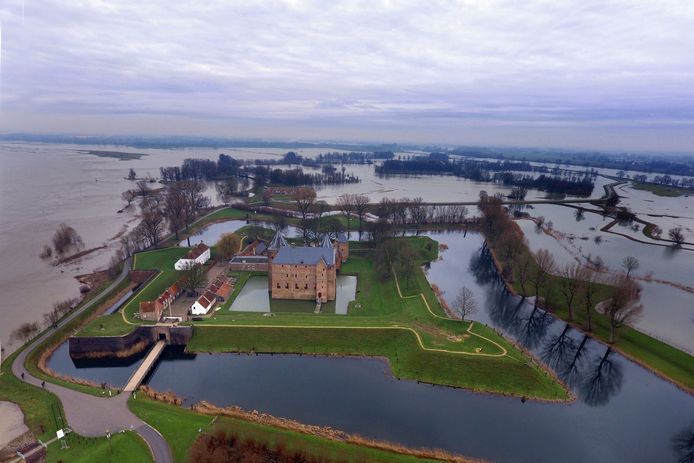
Yesterday and Present of the Fourteenth Century Castle
Roughly built in 1375 on a sandbar at the confluence of the Waal (the main stream of the lower Rhine through the Netherlands) and the Maas, Louvre has been connected to the outside world by water since then and remains so today. Since this is a well-preserved medieval castle, it once served as a high-level political prison in history, carrying rich Dutch history. Now the castle and its surrounding annexes are open to the public in the form of a museum. The adult ticket is 14 euros.
To visit the Louvre Castle Museum, there is only one way for tourists to take a boat from the pier in Hawken City , pick up and drop off passengers in the small town of Warwicken in the middle, and finally arrive at the sandbar where the Louvre Castle is located. Hocken and Warwicken are both fortified fortress cities. These two cities, together with the Lufu Fort on the sandbar and the other Würnberg with towers, collectively known as the "fortress delta", are the most complete defenses in the Netherlands. The waterway is now known as the most beautiful sightseeing waterway in the Netherlands. Tourists get on the boat in spring and summer, and they immediately feel that the view is wide and the heat disappears. The view is an endless lush green space, dotted with stone cities, and cattle and children can be seen along the river. Tourists who were playing in the river and gradually approaching the sandbar of the castle with the boat could not help but wonder: when Grosius was escorted to the Lufu Castle, was there such a leisurely beauty on the river?
However, the fascination of ancient times will always be the luxury of future generations. In the era of Grosius imprisoned in Louvre Castle, even in summer, it was cold enough to cause illness. Grosius spent two years in Louvre and was indeed ill. Fortunately, he successfully escaped from prison in 1621 and ran to freedom from then on. March 22 this year is the 400th anniversary of his escape from prison. Themed activities at the Floating Castle Museum.
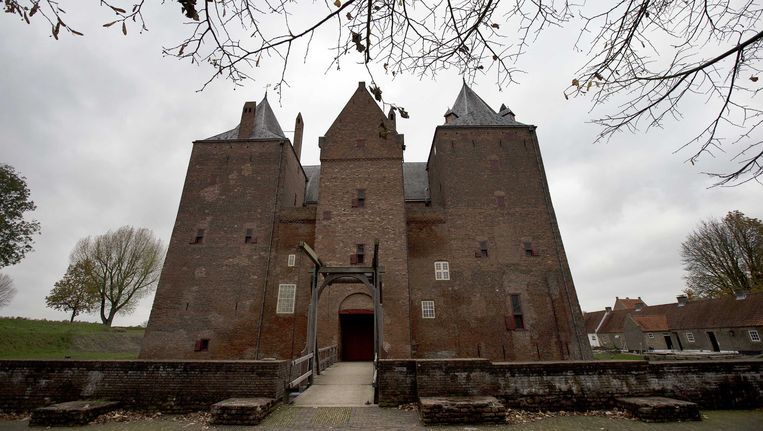
Castle Celebrates 400 Years of Escape
Grosius is famous internationally and is also a household name in the Netherlands, but most Dutch people do not know what great achievements Grosius had. In fact, in the minds of ordinary Dutch people, Grosius is just that "the man who escaped from the Louvre by hiding in a bookcase". The well-known (and roughly accurate) story states that Grosius, a high-ranking political prisoner, was allowed to live with his wife and children in the Fort Louvre, where his wife was free to move around the fort and cook three meals for him in the kitchen , but he can only move between the bedroom and the study. Grosius was a high-level intellectual, and was allowed to communicate with the outside world, as well as accept books sent by the outside world. His wife observed that the castle guards were gradually loosening up and stopped checking incoming and outgoing bookcases, so she planned a bookcase escape. Grosius hid in a bookcase in 1621 and was transported out of Faubourg as a book. After that, he fled the Netherlands and moved to Paris to become a member of the court of King Louis XIII of France.
The famous story of Grosius's book box escape has made museums all over the Netherlands claiming that they own the bookcase that contained Grosius. Among them, the bookcase of the National Museum seems to be the most realistic, although it has long been impossible to verify.
⇩ The picture shows the "Grossius' Bookbox" in the Rijksmuseum in Amsterdam.

Although the bookcases displayed by Louvre Castle are obviously too young and unlikely to have been passed down from the first half of the seventeenth century to the present, the sense of reality provided by the ancient castle itself can definitely make people wanting to experience history from all directions. Tourists shrouded their heads more than any other place that claimed to have a "Grossian Book Box". Tourists feel this soon after they disembark and board the sandbar.
Visitors must first go to the later-built brick buildings around the castle, buy tickets at the ticket office here, get a foldable guidebook and a key that can be hung around the neck, and enter the castle. And the induction tools necessary for listening to the audio guide in the fort.

Take the key through the extremely thick suspension bridge on the moat, and pass through the tunnel-like castle gate to the atrium of Lufu Castle. Just standing in this atrium and looking up at the sky makes people feel short of breath. Before tourists walk up the stairs and enter the fort, they tend to look back at the narrow atrium subconsciously. Grosius may have done the same four centuries ago. That is a kind of hardship that once you step into the door, you may never see the atrium of this confined person again in this life.

The insidious design of the museum can be seen everywhere in the Louvre. When a tourist was walking on the narrow and steep stone stairs that could only accommodate one person, he was about to complain about the terrible wind in the fort, when he turned the next corner and bumped into a metal decorative box with inscriptions. Words into the eyes of tourists:
"Don't be afraid of death, that's life!"
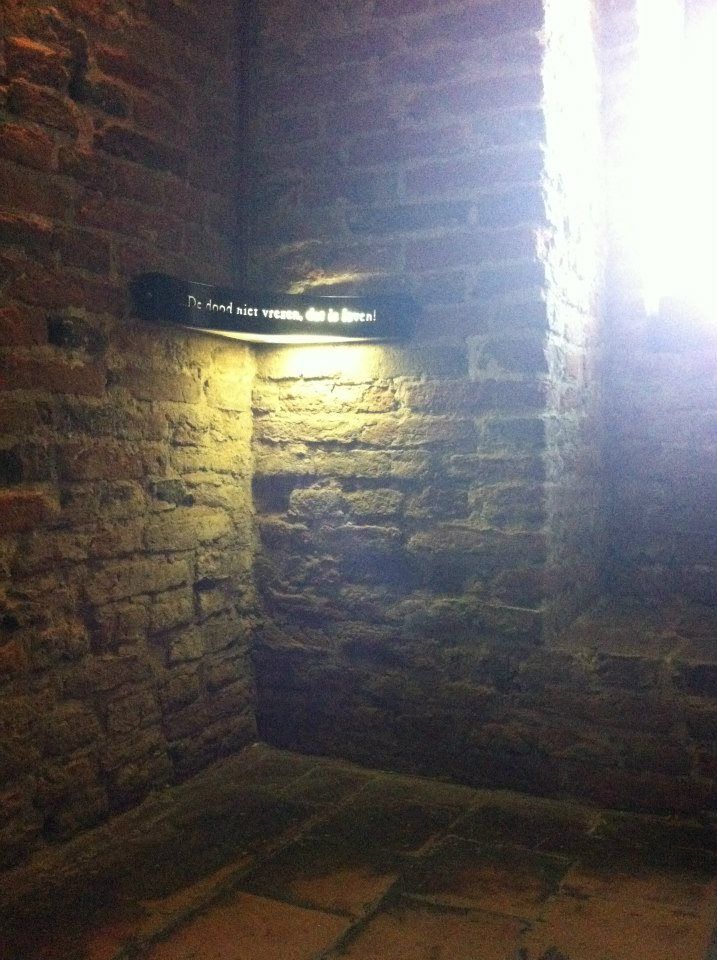
There are many political celebrities who have been imprisoned in the Fort Louvre, and there is a wide space in the fort to introduce these characters. However, Grosius was the only one who received special treatment from the Castle Museum. Because of the reputation of escape from the bookbox, Louvre was almost equal to Grosius in the hearts of ordinary Dutch people. The old castle retains his bedroom and an adjacent chapel, which is also his study. Visitors entering his bedroom will hear seventeenth-century Dutch music , probably familiar to Grosius. A projection may suddenly appear in the room, introducing the two years of Grosius' life here. The stone castle was originally gloomy and cold. In the seventeenth century, Europe was in the Little Ice Age, and it was very cold. Grosius was often sick, and he often read and wrote while sick. He communicated frequently with the outside world in prison. Taking 1621 as an example, before his successful escape on March 22, he sent a total of eight letters from January 10 to March 6, three of which were addressed to his brother, A letter was received on March 17, a few days before the jailbreak. The letters sent by Grosius were written in Latin, Dutch and French, depending on the custom of the correspondent.
In addition to theological and legal works, Grosius also left a large number of letters, which have been assembled and published, with a total of seventeen huge volumes. But despite the abundance of materials, few people can read them today. There may not be too many people who can read Latin, Dutch and French at the same time, but there are very few who know Latin, Dutch and French in the seventeenth century at the same time. In the Netherlands in the 21st century, only the historian Van Itasson is known as a "Grosius expert". ", "Freedom of the Seas" was actually one of the chapters in this big book.
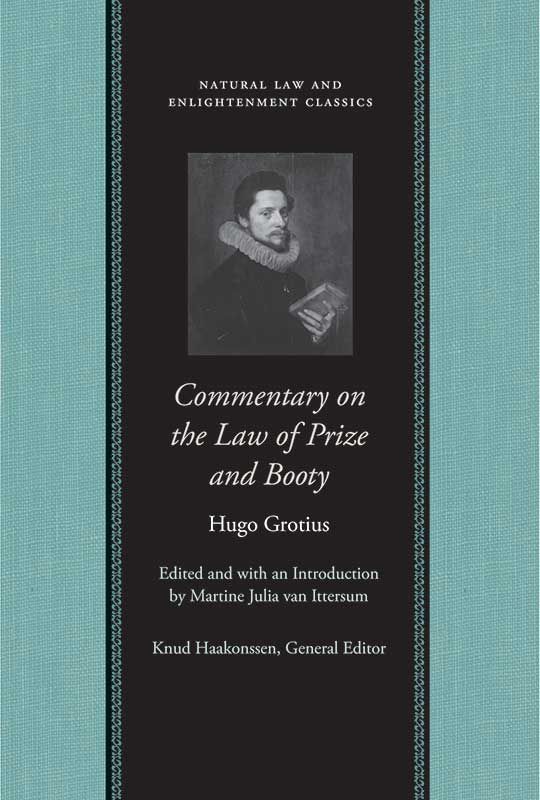
In addition to the seventeen tome letters, the National Archives of the Netherlands also has two Grosius files , which collect his diplomatic letters and personal communications, but these documents are of course unreadable except for a very small number of researchers with professional ability. It may also be due to the small number of people involved in the research. These documents have not been digitized so far, and researchers can only read microfilms that hurt their eyes in the archives.
If you can read first-hand historical materials, you can of course have a better understanding of Grosius, but time has set a limit for everything. Whether it is the historical materials of the National Archives or the collection of letters that have been published, the threshold is too high for ordinary people. In contrast, the story of the escape from the book box and the medieval castle standing on the banks of the Var river have become ordinary tourists. The best place to experience history.
In fact, even professional historians often need this kind of personal experience in order to inject a kind of understanding that transcends the times and appeals to human nature in historical articles. I myself have such an experience with Grosius. It was about ten years ago, and I was writing a chapter on the history of the Netherlands for the book New Netherlands , using Grosius as a clue to the history of Dutch independence. I went from Leiden University (where Grosius attended) to Delft, where Grosius was born, and walked into the new church of Delft, where he was baptized as a baby and was buried in a foreign land. He lived in the royal court where the Prince of Orange, who led the independent revolution but was assassinated, then moved to The Hague, Rotterdam and other cities where he once worked, and traveled almost all over the Netherlands. Yuetian first visited Louvre Castle, and the people I traveled with at that time also included our professor of archival science, Mr. Yan Pingshi.
The icy Lufu Castle had a shocking power that made everyone who walked into the castle at that time naturally silent. Upon entering Grosius's now-empty bedroom, I found a toilet cut into the wall. The "toilet" that can only seat one person is actually a vertical tunnel in a thick wall, from which the excrement falls directly into the unknown channel deep below that connects to the moat. I couldn't hold back my curiosity. I sat down on the 14th century "toilet". Even though I was wearing heavy winter clothes, I still felt an indescribable coldness. I then understand better than before I visited Louvre, what an "eternal" confinement is, and why a jurist who aspires to set a standard of justice for war and peace has to risk his life to escape this prison of indifference to everything .

After a while, Yan Plover and other friends followed the visit path back to the starting point. This starting point is also the end of our journey. Once again, we filed through the red-painted wooden door and stepped into the drizzly atrium. At the other end of the gate is the suspension bridge over the moat. The suspension bridge is the same as when we came, but between entering and exiting, the unobstructed road has become the embodiment of "freedom". As we waited at the pier for the ferry, we also realized that this vast waterway does not necessarily represent the freedom of navigation today, because it was also a means of imprisonment and obstruction. It is not difficult to understand why the seemingly common-sense concept of "freedom of the sea" was not put into practice until 1609 by Grosius.
This year marks the 400th anniversary of Grosius' successful escape, and many are expecting a celebration on March 22, but with the plague raging in the Netherlands and a curfew already in place, it's unclear what the situation will be. If Lufu Castle cannot hold events normally, many people will be disappointed, but Grosius knows the underground, so he shouldn't mind too much. Because his most influential book "Freedom of the Seas" has long told us that once the intellectual space is created, it cannot be erased, and the physical space becomes the second. Freedom lies first and foremost in human thought and understanding, thus making the ocean an ocean of freedom.
⇩ The picture shows the statue of Grosius in front of the New Church in Delft. The New Church of Delft is the cemetery of the Nassau royal family in Orange, the Netherlands. The statue of Grosius can stand in front of this church, indicating his irreplaceable position in the history of the Netherlands.
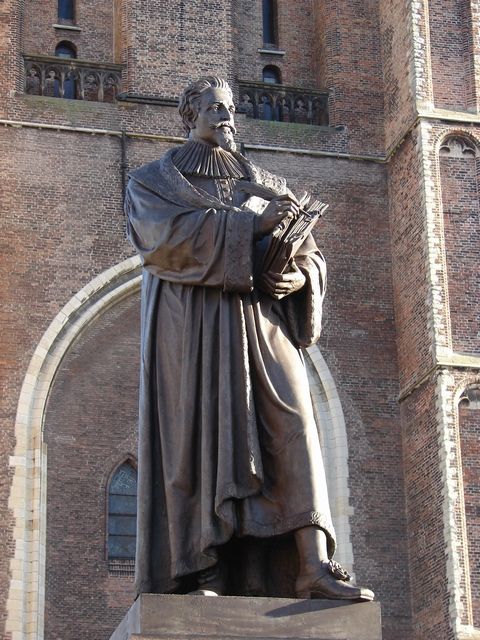
Go back to the little book "Freedom of the Seas" at the beginning of the story.
Without the "Freedom of the Seas" that silenced the whole of Europe, the Dutch East India Company could not have accumulated a lot of wealth in the distance, won the 80-year War of Independence on the European continent, and created the "Golden Age" of the Netherlands in the seventeenth century. In 1648, the Peace Treaty of Westphalia, which ended the religious wars in Europe, was the concrete realization of Grosius' "On the Laws of War and Peace", although he had died of shipwreck three years before that. Grosius was born in war, grew up in war, and died in war. Perhaps only the son of war is the most eager for peace, and finally he laid the foundation for peace in Europe with his legal theory. We cannot obtain such historical understanding and experience in the archives, but can only experience it in the process of interaction between our hearts and the environment.
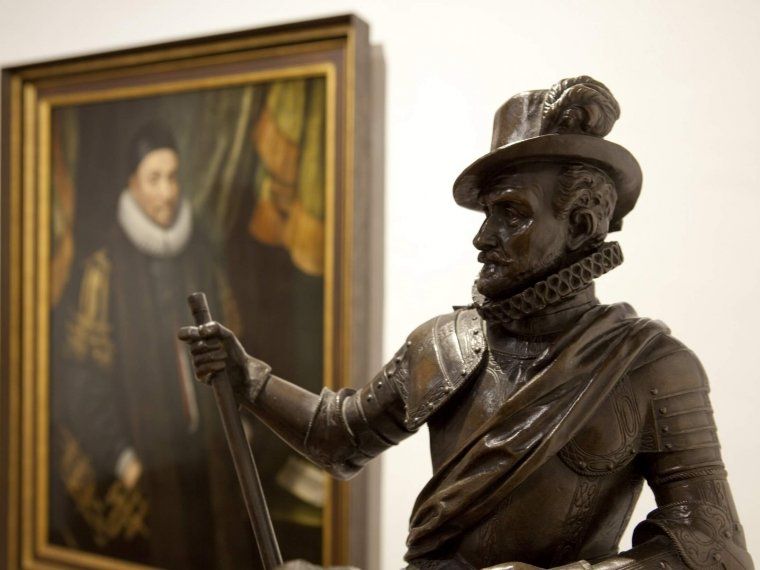
With the experience of meeting history outside the archives, let's go back to the archives and talk about what is an urban archive? What are the city archives doing? (Welcome to ask questions, you can jump in the queue)
Like my work?
Don't forget to support or like, so I know you are with me..
Comment…